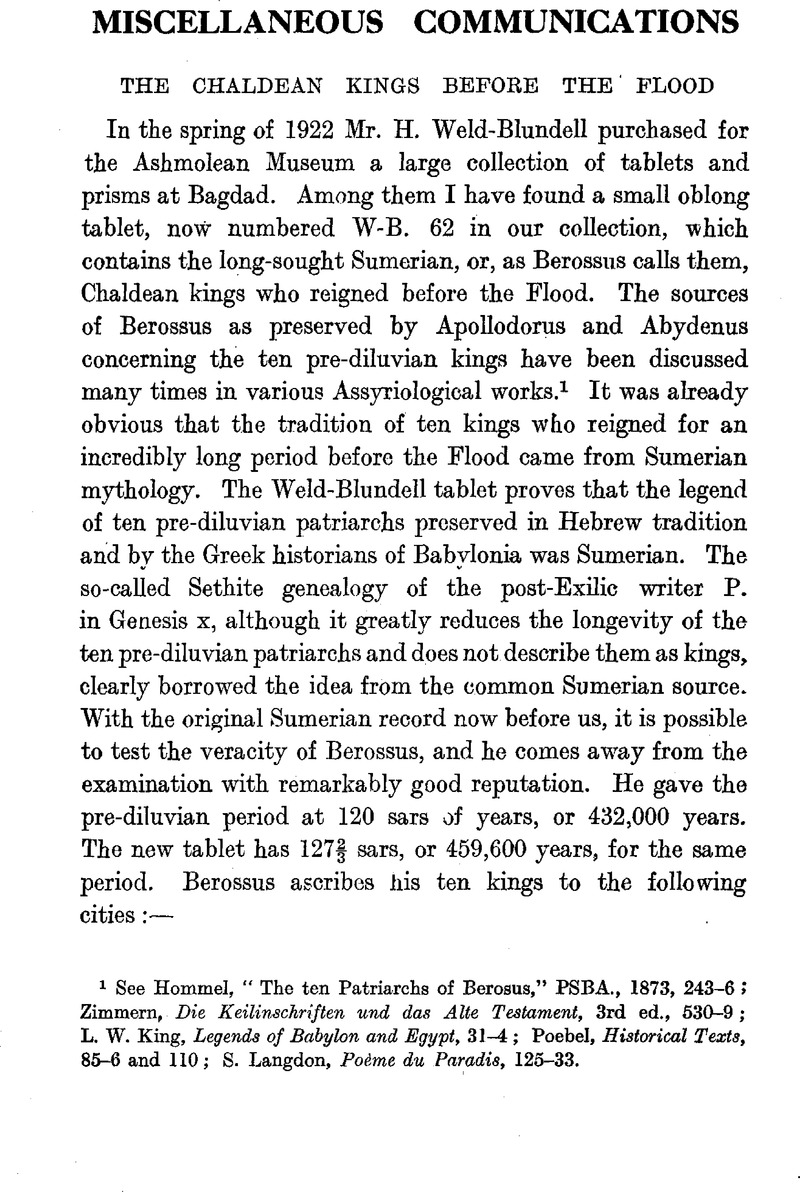No CrossRef data available.
Published online by Cambridge University Press: 15 March 2011

page 251 note 1 See Hommel, , “ The ten Patriarchs of Berosus,” PSBA., 1873, 243–246Google Scholar; Zimmern, Die Keilinschriften und das Alte Testament, 3rd ed., 530–9 ; L. W. King, Legends of Babylon and Egypt, 31–4 ; Poebel, Historical Texts, 85–6 and 110; S. Langdon, Poème du Paradis, 125–33.
page 252 note 1 I.e. Heaven-god, Earth-god, and Earth-mother goddess.
page 252 note 2 Title of Enki as creator of mankind.
page 252 note 3 nu-gig = ištaritu, a title of the virgin goddess Innini. See Tammuz and Ishtar, 81–2.
page 253 note 1 The older reading of this name, Durgurgur, was erroneous. For Tammuz, lord of Badtibira, v. SBP. 318, 8; Zimmern, Kultlieder, 34, 7; Radau, BE. 30, Nos. 6, 8; No. 5, R. 11 ; BE. 30, No. 1. Rev. 10 has Badtibira(ki) with É-innina-a, probably the name of the temple at Badtibira. The god Lugal-Badtibira(ki) in K. 11928 (CT. 25, 38) is probably Tammuz, but the names d. Tibira-kalam-ma and d. Tibira-dingir-ri-e-ne “Artisan of the Land”, “Artisan of the gods”, CT. 24, 12, 24–5 = 25, 87 are titles of the Mother goddess, Ninḫarsag, supposed in Nippurian tradition to have created mankind from clay. See Poème du Paradis, 23 ff. According to Poebel, PBS. v, 157 ; i, 5, the temple in Badtibira was E-innina-kalam-ma.
page 254 note 1 Thureau-Dangin, SAK. 208. The place is mentioned in letters of the period of Hammurabi; Ungnad, Babylonische Briefe, 17, 7 ; 31, 7 ; 52, 6 ; 54, 5 ; Lutz, Early Babylonian Letters from Larsa, 39, 6. Ungnad, No. 52, actually refers to metal workers, and Lutz, No, 39, alludes to copper at Badtibira. The word means “ Wall of the metal worker ”, and hence Hommel, Geographie, 358, identified it with the ruins of Tell Ṣifr, “ mound of copper ”, near Ellasar, eastward beyond the Shaṭṭ el-Kar. Loftus found traces of a great copper industry at Tell Ṣifr. The contracts excavated at Tell Ṣifr and published by Strassmaier, Die altbabylonische Verträge aus Warka, do not mention the city Badtibira.
page 255 note 1 See Poebel, Historical Texts, p. 43.
page 255 note 2 See JRAS., 1922, 431.
page 257 note 1 The group of signs here read alim is probably a local (Ellasar) variant of Thureau-Dangin, REC. 228. The name clearly represents the original of the Greek Ἄλωρος
page 257 note 2 For làl-gar apparently the name of a sanctuary of treasury in the inscriptions of Senecherib, see SAI 2120 ; CT. 26, col. v, 32, and the hymn to Dungi, CT. 36, 26, 10, làl-gar-ra-bi. A restoration [A]-làl-gar, Alagar, may conceivably afford an explanation of the name Ἀλπαρος, given by Berosus. The Greeks corrupted Γ (gamma) to Π pe(pi).
page 258 note 1 Berosus gave this name as Daōnus, a shepherd of Pantibiblus. Daōnus is obviously a textual corruption for Laōnus, a transcription of lu-an-na.
page 258 note 2 The group URUD-NAGAR has been read gurgur, cf. BL. 19, n. 2 ; but CT. 29, 46, 5 preserves the true reading of this group, ti-bi-ra ; tibira = ḳurḳurru metal worker, loan-word tabiru (v. Ungnad, ZA. 31, 276), is obviously the reading of this ideogram in the name of the city in question, and it also affords the lost original of the Greek Pantibiblos.
page 258 note 3 This name was, somehow, corrupted into Amempsinos in the text preserved by Berossus and occurs wrongly as the eighth king, not the seventh. Berossus preserved, however, the correct tradition regarding the length of his reign and his city.
page 258 note 4 Berossus preserves this name in the form Euedōrachos, and places him seventh in the list. The Greek tradition is possibly correct in giving Pantibiblos as the city of this king. The variant readings Euedōreschos, Aedōreschos of Abydenus, and Edōranchos of Eusebius, prove that the Sumerian original was En-me-dur-an-ki, in Babylonian tradition the founder of the art of divination. Zimmern had already explained this name correctly.
page 258 note 5 Written SU-KUR-LAM ; gin is omitted in line 15. Arad or Aratta is a title of the gods of Šuruppak ; v. PBS., x, 177, n. 4, for d.Aratta=Ninlil or Sud of Šuruppak, and for Arad or Aratta = Enlil, v. PSBA., 1911, 94 pl., 1. 5. Often in N.Pra. at Šuruppak ; Enim- d.Arad-da-zid, RTC. 15 Rev. end ; Lugal- d.Arad-kenag, 15, R. ii, 4, etc. The noun arad, arat really means kabtu, honoured, tanittu, honour, CT. xi, 49, 34–5.
page 258 note 6 Berossus has the name of the ninth king Opartes, substituting father for son. The length of this reign is correctly reported in Berossus. The scribe here employs ubur (SAI. 3891) for the ordinary ubar-kidinnu, protegé. The name Ubar-tu-tu, father of Utnapištim, occurs in the Epic of Gilgamish, xi, 23 ; ix, 6, but our text makes Uburtutu the grandfather of Utnapištim. Berossus assigned Opartes to Larak.
page 259 note 1 Or Aratta. Obviously the tradition, which on the basis of Apollodorus' version of Berossus assigns the ninth king to Larak, is erroneous. Alexander Polyhistor's summary of the history of Berossus is verified by the new text. Polyhistor gives the name of the ninth king Ἀρδτης, father of Xisuthrus; Ardates represents Aradda or Araddagin of the Ashmolean tablet. See Cory, Ancient Fragments, p. 26.
page 259 note 2 This name is translated by Uta-napištim-[arik] in the Babylonian legend of the Deluge, but Lucian, De dea Syria, 12, preserves the original Sumerian in the form Sisythes. Berossus gives Xisuthros as the name of the tenth king and the hero of the Deluge, a form based upon a Semitic title of Ziudsuddu. See Poème du Paradis, 133, n. 1.
page 259 note 3 For the current view, see e.g. Keith : Karma-Mīmāmasā, p. 11.
page 259 note 4 See Pañca-pādikā-vivaraṇa, pp. 45–6, and Siddhānta-leśa-saṅgraha (Kumbhakonam edition), p. 65.